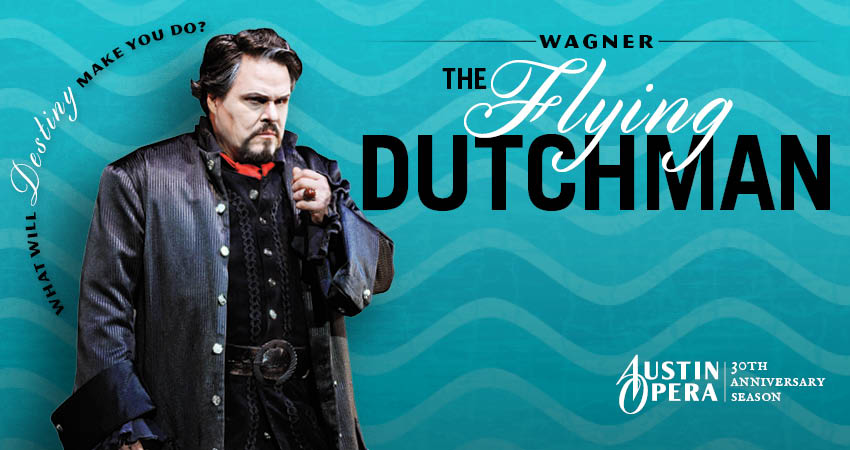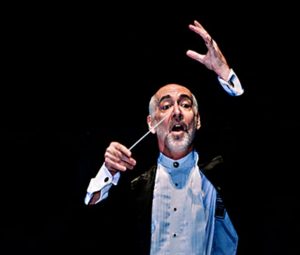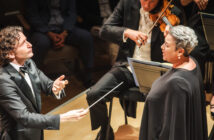WAGNER: The Flying Dutchman. Wayne Tigges (Dutchman); Peter Volpe (Daland); Melody Moore (Senta); Clay Hilley (Erik). Eric Einhorn (stage director). Michael Baumgarten (lighting and video designer). Austin Opera Chorus and Orchestra/Richard Buckley. Long Center for the Performing Arts. Austin, Texas. November 12, 2016
Austin Opera opened its 2016-2017 season with a Wagner opera, an ambitious undertaking for a regional company of modest means. That said, any opera company anywhere that avoids presenting Wagner operas, either because they require too much effort or too much money, is not properly serving its community.
Austin in 2016 is large enough and wealthy enough not only to support an important opera company but also to mount a Wagner production: today, The Flying Dutchman – tomorrow, the Ring. That was certainly the implication of artistic director Richard Buckley’s program note in which he recalled his days as musical administrator at Seattle Opera, the company which has made its productions of the Ring major events. For the record, Austin Opera, under its former name Austin Lyric Opera, has presented The Flying Dutchman before (2003-2004 season), but its Wagner productions have been few and far between: in 30 seasons it has done only The Flying Dutchman (2003; 2016), Tannhäuser (1996) and Die Walküre (2001).
The Flying Dutchman is the first opera in which the mature Wagner begins to emerge. Very fond of the piece, which embodies one of his favorite themes (i.e., redemption of a flawed man through love of a woman culminating in a love-death), he returned to it often in later years to make revisions. The flawed man in this case is the nameless “Dutchman,” condemned to endlessly sail the seas because he uttered a curse. For one day and night every seven years he is permitted to go ashore; there, if he can find a woman to love him, he will be redeemed and his endless wandering will cease. In this opera, he finds such a woman and she sacrifices her own life to redeem him.
The score of The Flying Dutchman abounds in strokes of genius. The music Wagner conceived to convey the fury of the sea is so vivid one can almost feel and smell the ocean. The conflict between the Norwegian sailors and the Dutchman’s crew in Act 3 is remarkably powerful. The figure of the Dutchman himself is unforgettable, and his music in “Die Frist ist um” in Act 1 and “Wie aus der Ferne” near the end of Act 2 is character portrayal in music of the highest order.
Unfortunately, the role of the Dutchman is almost beyond any mere mortal’s ability to do it justice. It requires a bass-baritone with not only enough metal in his voice to be heard over the formidable Wagner orchestra, but also with a lieder singer’s ability to sustain long lines at a conversational level. Wayne Tigges, a singer with modest vocal skills for this particular role, never managed to fully convey the mystery and the seething passion of the character.
On the other hand, Melody Moore as Senta was a formidable presence with a powerful voice, especially in the bottom and middle registers. In her duet with the Dutchman she simply overpowered him. That is not usually a good thing but in this case Tigges simply failed to hold up his end.
Tenor Clay Hilley as Erik also made a strong impression. He did have some metal in his voice and made the most of his opportunities. Bass Peter Volpe as Daland was excellent.
Eric Einhorn’s staging had some anomalies: leaving the Dutchman downstage right at the end of Act 1 seemed weak and unconvincing; the portrait of the Dutchman in Daland’s living room was impressionistic when it should have been exact – Senta recognizes the Dutchman when she finally meets him in person because she has been mesmerized by his portrait for years; and the choral battle between the two crews in Act 3 totally failed to come off. On a positive note, the lighting and video effects created by Michael Baumgarten to complement the staging added immensely to the storytelling.
The substantially enlarged Austin Opera Orchestra played well and Richard Buckley conducted with his usual sensitivity and command. There is a good deal of important choral work in The Flying Dutchman and under the direction of Julian Reed, the choral forces were both accurate and enthusiastic.
For all its faults, this production of The Flying Dutchman was a credible effort. I applaud the company for bringing back the opera after a thirteen-year absence, and look forward to productions of Tristan und Isolde and even the Ring in the not too distant future.

















